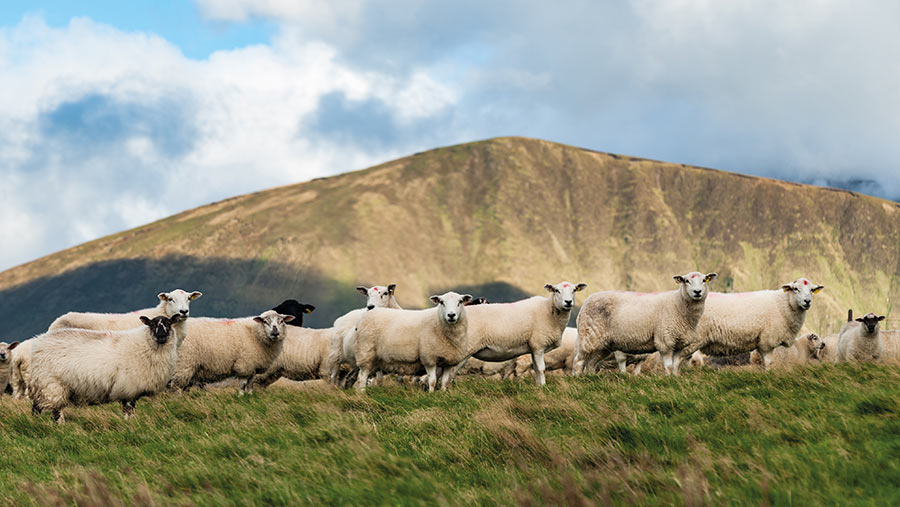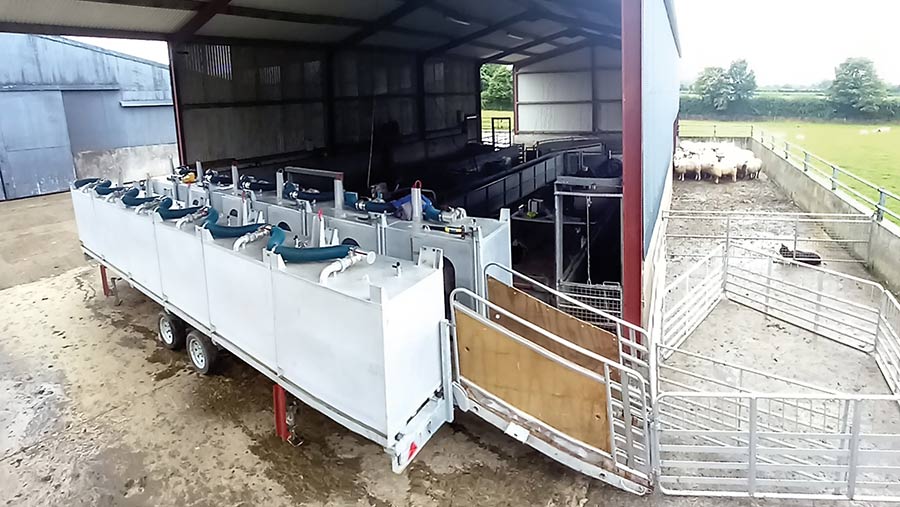Sheep breeding index reduces methane and betters performance
 © Gabriel Cassan/Adobe Stock
© Gabriel Cassan/Adobe Stock Results from thousands of methane measurements from sheep flocks across Ireland have confirmed that genetics play a part in enteric fermentation.
This means farmers can select for low emitters, reducing greenhouse gas (GHG) emissions and improving productivity in the process.
See also: 17 ways sheep farmers can work towards net zero
This is according to Nóirín McHugh, senior research officer at Teagasc’s animal and biosciences department.
She is confident a methane trait will be incorporated into Ireland’s national sheep breeding indexes by 2023-24.
“Methane is an inefficiency in the system,” says Dr McHugh. “It’s energy the animal isn’t using to convert grass into product such as meat. It equates to a 2-12% loss of feed energy.
“Anything we can do to reduce methane within the animal will also improve efficiency, so it’s a win-win in terms of action.”
Emissions from sheep
Agriculture is Ireland’s biggest single emitter of GHGs, responsible for producing just over one-third of the country’s total emissions.
This has resulted in bad press for the industry on a weekly, or even daily, basis, she says.
An average sheep produces about 11kg carbon dioxide equivalent (CO2e)/kg liveweight. This equates to 10% of GHG emissions from agriculture. Of that 11kg, 7kg is down to methane produced by enteric fermentation, she adds.
As well as taking steps such as improving grassland management and maintaining soil fertility, breeding strategies such as selecting for faster growth, targeting higher prolificacy and lowering age at first lambing can be used to reduce GHG emissions.
Currently, Irish sheep farmers can use Sheep Ireland’s Euro-Star terminal and replacement indexes to help them select animals with high genetic merit.
Initial study
To determine how that selection process impacts farm profitability and GHG emissions, Dr McHugh and her team used real data from commercial flocks to model two flocks (see “Comparison of performance and GHG emissions between one-star flock and five-star flock”).
A higher weaning rate and lower number of days to slaughter amounted to an increase of €18 (£15.68) a ewe in the five-star flock.
The researchers also looked at GHG intensity between the two flocks and calculated a reduction in CO2e of 7% from the five-star flock.
Comparison of performance and GHG emissions between one-star flock and five-star flock |
||
|
|
One-star flock |
Five-star flock |
|
Flock size |
257 ewes |
257 ewes |
|
Area |
20ha (49 acres) |
20ha (49 acres) |
|
Weaning rate (lambs a ewe) |
1.54 |
1.70 |
|
Days to slaughter |
203 |
190 |
|
Improvement in productivity (€/ewe) (£/ewe) |
– |
+18 (+15.68) |
|
Emissions (CO2e/kg product) |
>23 |
22 |
|
Reduction in emissions (%) |
– |
7 |
|
Note: The one-star flock represented the lowest 20% genetic merit for replacement-type traits, while the five-star flock used top genetic lines |
||
“It’s a very good news story: selecting on indexes currently is improving productivity, economic performance and GHG intensity at the flock level,” says Dr McHugh.
“However, in Ireland, when we talk about GHGs and the targets laid down by the government, it’s total GHG emissions from our sector, not GHGs/unit of product. So, to reduce total GHG emissions, we really have to select directly for methane emissions.”
That means measuring methane in individual sheep to identify high and low emitters in flocks and, ultimately, to develop breeding values for methane, she explains.
Predicting methane emissions
To do this, Dr McHugh and her team are measuring methane emissions from flocks across Ireland using 12 portable accumulation chambers (Pacs) mounted on a trailer.
On each farm, 12 sheep are removed from their feed source one hour before entering the Pacs, where methane, carbon dioxide and oxygen measurements are taken at 0, 25 and 50 minutes.

12 portable accumulation chambers (Pacs) mounted on a trailer © Eoin Dunne
This method gives a good predictor of methane emissions and is a very useful way of ranking sheep, says Dr McHugh.
From the data collected so far, the team has found a dry ewe will produce 19.29g methane/day.
This compares with 240g/day from a lactating cow and 230g/day from a finishing steer.
“Sheep aren’t the main culprit,” says Dr McHugh. “But, if we express this in methane/kg liveweight, it’s 0.4-0.6g, which is very comparable to a dairy cow or a beef steer.”
Genetic influence
Further research has shown methane output increases as sheep grow and is highly correlated to feed intake.
However, there is a lot of variation – and this raised the question of how much of this is down to genetics, and whether animals can be selected genetically to produce less methane for the same level of output.
Results so far, based on 12,000 measurements from commercial and pedigree flocks, are promising: they indicate that methane has a heritability of 25%.
“This means if you have two animals, 25% of the difference in the methane produced by them is down to genetics,” she says.
“It’s not down to diet, breed or the age of the animal; it’s purely down to the genetic makeup of the animal. This is pretty comparable to what we have for lamb liveweights here.
“The other good news is that it’s about 40% repeatable – that tells us that if we measure an animal at an earlier stage of life, we will have a good predictor of what methane profile it will have later in life. So again, it allows us to build up a picture very quickly.”
Actual breeding values
The aim now is to get the methane trait incorporated into actual breeding values, and to see methane values displayed alongside existing star ratings for the national terminal and replacement indexes.
Farmers in Ireland can then use these when they are selecting a ram for the breeding season. The goal is to have this in place by 2023-24.
No one breed is going to solve the problem, says Dr McHugh, and there is as much variation within breeds as across them – about 8g methane/day difference between the lowest and highest emitters.
“The important thing is not to lose sight of the fact that we don’t want a sheep that’s producing low methane but not ticking the boxes for everything else.
“So, we need to link it to the other production traits to make sure we’re selecting animals that have reduced methane but also high prolificacy, high growth rates, good health and so on.
“So, in the future, we want to breed these low emitters but also maintain our high levels of performance.”
A carbon value sub-index within the terminal and replacement indexes is also being considered.
This would allow farmers to delve more deeply into specific traits, as they already can for lambing, growth and carcass sub-indexes.
Nóirín McHugh was speaking at an AHDB webinar on breeding sheep to reduce methane emissions
